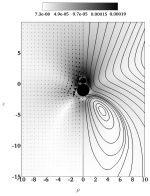EPJ E Highlight - Optimum inertial self-propulsion design for snowman-like nanorobot
- Details
- Published on 22 July 2014

A new study investigates the effects of small but finite inertia on the propulsion of micro and nano-scale swimming machines that could have implications for biomedical applications
Scale plays a major role in locomotion. Swimming microorganisms, such as bacteria and spermatozoa, are subjected to relatively small inertial forces compared to the viscous forces exerted by the surrounding fluid. Such low-level inertia makes self-propulsion a major challenge. Now, scientists have found that the direction of propulsion made possible by such inertia is opposite to that induced by a viscoelastic fluid. These findings have been published in EPJ E by François Nadal from the Alternative Energies and Atomic Energy Commission (CEA), in Le Barp, France, and colleagues. This study could help optimise the design of self-propelled micro- and nanoscale artificial swimming machines to improve their mobility in medical applications.
The authors focused on two joined spheres of different radii—dubbed a dumbbell—rotating in a model fluid. They first use simulation to study the effect of a small-scale inertial force on the dumbbell’s propulsion. They then compare it with results from theoretical calculations describing locomotion.
They demonstrate that despite the geometrical asymmetry, such a dumbbell cannot self-propel in a pure Newtonian fluid—which is a model fluid whose viscosity does not change with its flow rate—in the absence of inertia. This is because of the underlying laws of physics. If a dumbbell rotating in the counter-clockwise direction propels upwards in the absence of inertia, it would have to move downwards when rotating in the counter-clockwise direction. As both problems are mirror-image symmetric from each other, their propulsion should occur in the same direction and thus without inertia a rotating dumbbell cannot self-propel.
In contrast, the study shows that a rotating dumbbell propels with the large sphere due to intertial forces in the fluid and the small sphere ahead in a pure viscoelastic fluid. With this in mind, the authors then derive the optimal dumbbell geometry for a self-propelling small-scale swimmer.
Rotational propulsion enabled by inertia. F. Nadal, O. S. Pak, L. Zhu, L. Brandt, and E. Lauga (2014), Eur. Phys. J. E 37: 60, DOI 10.1140/epje/i2014-14060-y




